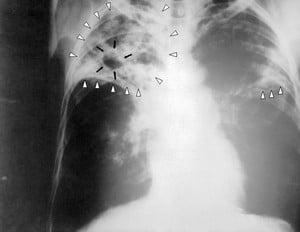An abbreviation for Tubercle bacillus, TB is the result of infection with a slow growing, wax-coated acid-fast bacterium that can remain viable in dried aerosol droplets for 8 months. Although few of those infected with the bacteria will actually contract the tuberculosis, it takes only one M. tuberculosis bacterium to start the disease process.
Transmission of Tuberculosis
The majority of TB infections are restricted to the lungs, after inhalation of respiratory droplets expelled when an infected individual coughs, sneezes or speaks. Still, it is possible for the bacteria to disseminate and cause infection in other areas of the body.
Tuberculosis Infection
Infection with Tuburcle bacillus (most often M. tuberculosis) is characterized by the formation of tubercles, hard nodules in the lungs that are the result of interaction between the bacteria and the host’s immune system. When M. tuberculosis enters the lungs, phagocytic cells of the host’s immune system, called macrophages, engulf the pathogen, but are unable to digest the bacteria due to its waxy mycolic acid cell wall.
The Mycobacteria then begin to multiply within the macrophages, eventually killing the very cells that are supposed to be protecting the host. The cycle continues as the bacteria released from the dead macrophages are then engulfed by other macrophages. While this immune system drama is being played out internally, the host typically shows few external signs of infection, other than a possible fever.
The infected macrophages result in an inflammatory response (heat, swelling, dilated capillaries) which attracts more macrophages until the site of infection is completely surrounded by many of these compressed phagocytic cells. Inflammation triggers other cells within the host to essentially quarantine the area by depositing collagen fibers around the packed macrophages, forming an enclosed infection within the lung called a tubercle. The cells at the center of the tubercle may eventually die, producing either an area of necrosis or an actual cavity.
Types of Tuberculosis
Tuberculosis is divided into three clinically important categories:
- Primary TB
- Secondary Reactivated TB
- Disseminated TB
Primary Tuberculosis
Primary tuberculosis refers to the infection process which eventually eliminates the pathogen or results in a stalemate between the Mycobacteria and the immune system. With most TB infections, the immune system is able to contain, although not eliminate, the Mycobacteria within the tubercle, preventing the spread of bacteria and progression of the disease. M. tuberculosis can remain in this impasse of dormant infection for many years.
Secondary or Reactivated Tuberculosis
The infection can become reactivated if the Mycobacteria are able to rupture the tubercle and spread through the lungs. This reactivation typically happens to those with a weakened or suppressed immune system.
Disseminated Tuberculosis
The spread of the disease within the body may result if infected macrophages moving through the blood and lymph transport the bacteria to other sites. Once infected, symptoms of disseminated TB correspond to the locations infected. The antiquated term “consumption” arose from the myriad of symptoms associated with disseminated tuberculosis, when those infected seemed to slowly waste away.
Sources
CDC Website (2008) Division of Tuberculosis Elimination.
Bauman, R. (2005) Microbiology. Pearson Benjamin Cummings.
* This article, which originally appeared in Suite101 online magazine, is not intended to be used for self-diagnosis or treatment of disease. If you are ill, consult a doctor, not a computer.



